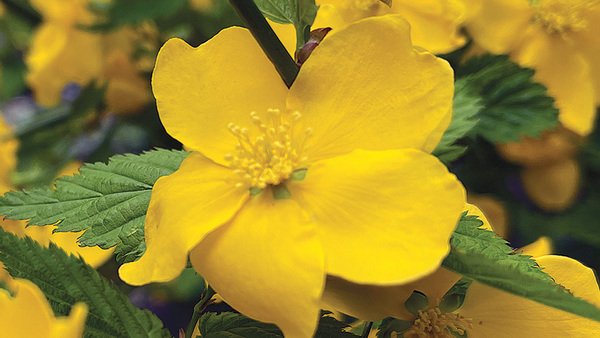
While many of us think of trees as super-tall giants or stand-alone specimen plants, we also know that most trees naturally grow in forests and that forests aren’t all made up only of tall trees. There are trees that mature at different levels, and certain trees prefer growing in the dappled light of their taller neighbors. We call these understory trees, and there are many that work well in our home gardens, adding interesting forms and structures, colorful blooms, or intriguing foliage. They also can provide food and shelter for wildlife. The following trees and shrubs all take full sun to partial shade. So if you’ve got some dappled shade under a tall canopy of trees, consider one of these excellent options.

Serviceberry
Amelanchier canadensis, Zones 4–8
There’s a good reason why the once-overlooked serviceberry has become the darling of landscape designers looking to include more native plants in their designs. This is a native tree that seems to offer the complete package: hardiness, early spring flowers, and spectacular fall foliage.
Nurseries offer many newer named selections, each offering a different benefit, such as straighter stems or trunks or larger fruit. You may notice that a garden center might offer both shrubby plants as well as single-stemmed trees in nursery containers, but you should know early on what you want, as it’s difficult to train a shrubby specimen to grow as a perfectly shaped tree, or vice versa. It seems that each serviceberry has its own personality and habit, and ultimately you just can’t convince one to grow a certain way, especially if you want a taller single-trunked tree.
That said, few natives are as useful in the northeastern garden. Hardy to Zone 4 and growing up to 30 feet tall, serviceberry is often the first plant to bloom in most gardens, even beating out forsythia (Forsythia spp. and cvs., Zones 3–9). As such, it’s naturally a valuable pollinator plant, and those white clouds of flowers mean that there’s a lot of valuable edible fruit for native birds in late summer. As with most members of the rose family, ripe serviceberry fruits are edible, and they are commonly used to make delicious violet-colored jams.

‘Argentea’ pagoda dogwood
Cornus alternifolia ‘Argentea’, Zones 3–7
Few trees are as attractive as this variegated nativar. Pagoda dogwood forms its branches in clearly defined tiers parallel to the ground. This unique habit is very distinctive. The flat tiers viewed from a distance are stunning.
Be prepared for a pagoda dogwood to grow as wide as it is tall. Mature specimens can reach up to 25 feet tall. The horizontal branches should never be cut or trimmed. This tree enjoys acidic soil and rich woodland loam that remains somewhat moist, but not too wet, throughout summer.
A trick to get this tree established adequately is to choose a young one with a distinct leader. As with many dogwoods, the roots are fibrous and sensitive to transplant shock, so avoid disturbing the rootball.
While this tree is a dogwood, it isn’t known for its showy floral display. It blooms in early summer, when every branch is covered with a flat network of umbels containing tiny flowers that attract pollinators. Still, who needs flowers when the variegated form of this tree looks as if it’s in bloom from early spring until autumn?

‘Hartlage Wine’ sweetshrub
Calycanthus × raulstonii ‘Hartlage Wine’
This shrub is the result of a cross between our native eastern sweetshrub (Calycanthus floridus, Zones 4–9), also called Carolina allspice, and a closely related Asian species, Chinese sweetshrub (Calycanthus chinensis, Zones 6–8). ‘Hartlage Wine’ and the other named selections of this cross grow larger than eastern sweetshrub at 10 feet or taller.
Glossy leaves appear in late spring on multiple branches, but large, slightly fragrant red-wine flowers steal the show in late spring or early summer. The late appearance of these flowers means that they avoid any frost damage.
‘Hartlage Wine’ sweetshrub should be pruned from an early age, which is the ideal time to decide if you want it to grow as a small tree or as a multistemmed shrub. If you prefer the latter, allow the many root suckers to form multiple trunks, which can be highly effective if you use the plant as a property divider or to hide a neighbor’s swimming pool.
Rarely affected by diseases or pests, ‘Hartlage Wine’ grows best under tall deciduous trees or in an open spot that receives some shade from nearby buildings. It’s a natural choice for woodland gardens or mixed shrub borders where the soil remains moist and ideally is rich with leaf mold or loam, as a forest setting might offer. This shrub is also deer tolerant and a vigorous grower.
Perennials are not the only plants you can grow underneath taller trees. Try out any one of these stunning shrubs or trees to add some pizazz to your understory.
For more about planting in an understory, check out:
- Conifers for Shade
- Small Trees That Like Shade
- Shade Gardening: How to Plant Under Mature Trees and More
For more Northeast regional reports, click here.
Matt Mattus is the author of two books: Mastering the Art of Flower Gardening and Mastering the Art of Vegetable Gardening. He gardens in Worcester, Massachusetts.
Photos: Matt Mattus


















Comments
Log in or create an account to post a comment.
Sign up Log in